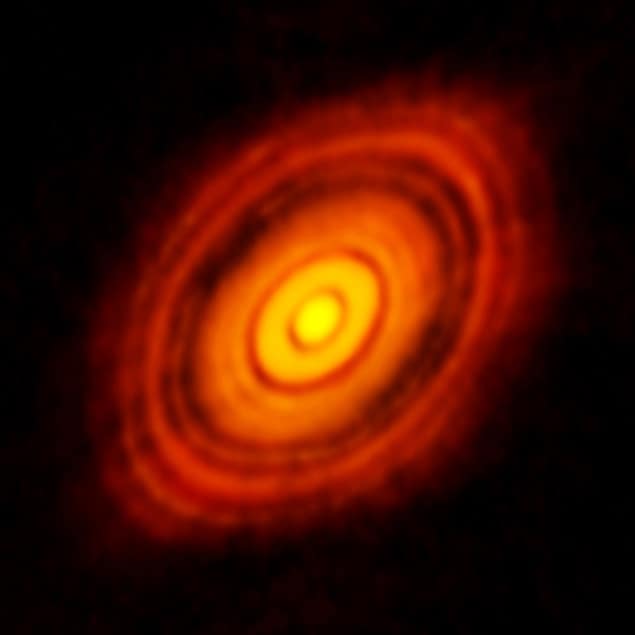
The clearest image yet of planets forming around a star has been unveiled by astronomers working on the ALMA array of radio telescopes in Chile. The image shows a series of concentric rings of material surrounding HL Tauri – a very young star that is only about one million years old.
“When we first saw this image, we were astounded at the spectacular level of detail,” says Catherine Vlahakis, ALMA deputy programme scientist. “HL Tauri is no more than a million years old, yet already its disc appears to be full of forming planets. This one image alone will revolutionize theories of planet formation”.
HL Tauri is about 450 light-years away, and is expected to evolve into a “main sequence” star like the Sun. Indeed, the ALMA team believes that HL Tauri provides a glimpse of what our solar system looked like more than four billion years ago, when the Earth and other planets were forming.
Swept-out orbits
Stars form within clouds of gas and dust, and some of this material will end up orbiting the star. Over time, some of this material binds together to form increasingly large pieces of rock and ice, which create a thin disc around the star. Then, material in the disc will join up to create large structures such as asteroids, comets and planets. The HL Tauri system appears to be at the point in its evolution when the nascent planets have acquired enough mass to “sweep out” smaller objects from their orbits, creating the observed structure of rings.
Images with this level of detail have, up to now, been relegated to computer simulations or artist’s impressions
Tim de Zeeuw, director-general of ESO
“These features are almost certainly the result of young planet-like bodies that are being formed in the disc,” says ALMA’s deputy director Stuartt Corder. “This is surprising, since such young stars are not expected to have large planetary bodies capable of producing the structures we see in this image.”
“Most of what we know about planet formation today is based on theory,” explains Tim de Zeeuw, director-general of the European Southern Observatory (ESO), which part-funded ALMA. “Images with this level of detail have, up to now, been relegated to computer simulations or artist’s impressions.”
Spaced-out antennas
The spatial resolution of the image is about five times the distance between the Earth and the Sun, which is better than could be achieved by the Hubble Space Telescope. This high resolution was achieved by spacing the individual ALMA antennas – located in the Atacama Desert – as much as 15 km apart. When connected together, the array functions as a giant radio telescope with a resolution that is much better than an individual antenna.
- There is much more about the formation of exoplanets in this feature article by Michael Meyer of ETH Zurich: “Recipes for planet formation”



